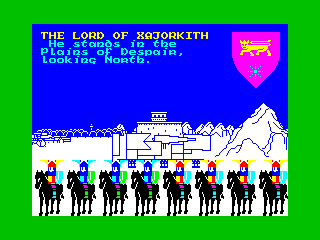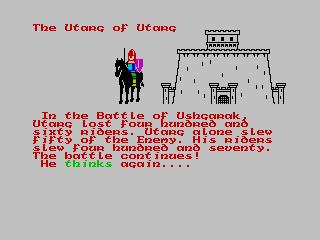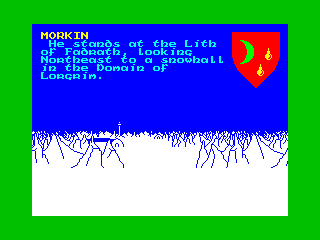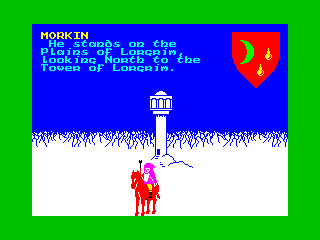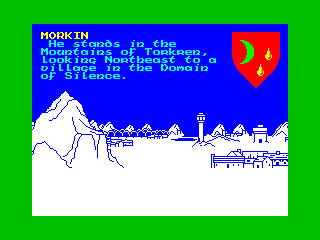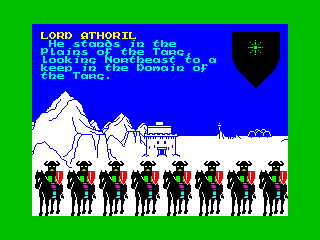Read the manual here:
Seastalker, a collaboration between children's author Jim Lawrence and Stu Galley of Infocom's The Witness from the previous year, holds a couple of interesting distinctions.
- It's the final game to come in Infocom's folio format packaging. All subsequent releases, including re-releases, would be in gray boxes more typical of the industry.
- It is the only Infocom game to carry the "Junior" difficulty rating. That designation would be replaced by "Introductory" with 1985's Wishbringer.
- It is the first Infocom game to support the Apple Macintosh, and with it, comes support for proportional fonts (I ran into trouble with Infidel when Frotz was set to use one).
- It's the first Infocom game to support Curses-like text output functionality, allowing individual characters to be changed on the screen rather than just printing new lines and scrolling.
- Despite being one of the smallest Infocom games, at just 30 rooms (tied with The Witness), it is the most complexly coded one yet, with over 14,000 opcodes. All prior games had about 6,000-9,000.
There's something down there, something terrifying. Now you've got to face it... because now only you can save the Aquadome - the world's first undersea research station. So states the packaging of Seastalker, promising mystery, thrills, adventure, and tests of skill and courage.
Inside the folio is a nautical chart of the bay, a set of dual-sided "infocards" with information about the characters and equipment on one side and Invisiclues on the other, a red-filmed "decoder" used to read them, a "Scimitar Logbook," and a "Discovery Squad" sticker.
The Scimitar Logbook is Seastalker's manual, in which a letter from the president personally congratulates us, a Tom Swift-like protagonist, for engineering the Scimitar, a highly advanced two-seater submarine, and our consequent acceptance into the ultra-prestigious marine research institute Discovery Squad. Following that, we have blueprints and instructions on operating the Scimitar, the usual instructions, and maps of the lab and Aquadome areas, which you typically didn't get in the manual.
There is a playtip that I strongly suggest following, that I wish I had known before playing myself. When the game suggests that you read a clue card, do it. The scanned cards at MOCAGH don't provide a great way of reading the clue sides, but these ones do. Toward the beginning of the game you don't really need them, and in fact, the mere prompting will spoil puzzles that were easy anyway by revealing contextual clues in keywords. But later on, they will reveal critical information that the game keeps from you, such as that an oxygen kit is found under your seat. And there's dialog that makes absolutely no sense unless the clue you are prompted to read in the middle of the conversation is assumed to be information dispensed by the character you are speaking to.
My initial playthrough, in which I did not use the clue cards at all, was quite a bit more confused than my final one, and I replayed and rewrote large portions of this post after I realized the true importance of the clue cards. Consequently, this post is somewhat of a false narrative, combining the experience of both my first playthrough, in which I discovered things for the first time but did not use the clue cards at all, and my final one, in which I always read the clue cards, but otherwise made an attempt to form decisions as if I were playing for the first time, not knowing what awaited me.
Upon loading Seastalker, you're prompted to enter your name so that the story can be personalized.
SEASTALKER: CAPTAIN AHAB AND THE ULTRAMARINE BIOCEPTOR
Junior-level interactive fiction from Infocom
Copyright (c) 1984 Infocom, Inc. All rights reserved.
SEASTALKER is a trademark of Infocom, Inc.
Revision number 16 / Serial number 850603
"Captain, snap out of it!" cries Tip Randall, bursting into your laboratory. "The alert signal is on!"
You look up from your plans for the SCIMITAR, a top-secret submarine that's still being tested. It's designed for capturing marine life on the ocean floor. You notice the alarm bell on the videophone ringing. Someone's trying to reach you over the private videophone network of Inventions Unlimited!
(lab center)
You're at your workbench in the center of your laboratory, a small part of the Ahab Research Lab in the town of Frobton. The videophone screen looms overhead, with its alarm bell ringing.
Tip is here.
A microphone is sitting on your workbench.
Okay, Captain, what do you want to do now?
>
The caller is Commander Bly, head of the Aquadome, sending a distress message. The facility is under attack from an enormous sea monster, nicknamed "The Snark" by their divers.
As with earlier Infocom games, you can't really converse with these characters, only give them commands, though "Bly, tell me about the monster" works as a line of inquiry. After questioning her and Tip some, I learned that the Scimitar, moored at the lab, can reach the Aquadome by autopilot, but hasn't been tested yet. And then the phone conked out.
At Tip's suggestion, I went to the Computestor console and turned it on.
"Symptoms: no picture, no sound.
Possible causes:
1) Failure of the transmitter at source.
2) A short in the undersea coaxial cable linking transmitter to the Ahab Research Lab, if signal is coming from Aquadome.
3) Sunspot interference or satellite malfunction if transmitter is at earth's surface.
4) Failure of the video receiver.
5) Overload in the Electrical Panel (circuit breaker popped).
6) Sabotage (circuit breaker open)."
Ok, so some of those causes are things I can't do anything about, especially given the urgency of the situation. But it would be nice if the Computestor could rule some of those things out.
Even though maps are included in the manual, I Trizborted out the lab as I always do. It's part of the fun, and I trust my own maps more. As I explored, Tip followed around, and occasionally the game would not-too-subtly suggest I look at the hint cards, as if it were getting impatient with my methods and eager to get on with it already.
The main lab area is a five-room arrangement with north, east, south, and west rooms encircled around a center, with spare electronics, mechanical parts, and chemicals haphazardly stacked on the shelves in several likely OSHA violations. To the south, a walkway loops around the Scimitar's access hatch. To the east is a corridor leading to the office of lab assistant Sharon Kemp, a useless storage closet, and an electric panel which, as the Computestor suggested as a possibility, had been tripped. Tip, surprised, said we had not overloaded the breaker, which left sabotage as the other possibility. I inspected Kemp's office, couldn't find anything suspicious, but she wasn't there.
Resetting the breaker fixed the video phone, but the line was dead, and Bly wasn't answering my return call. Time to head out in the Scimitar, but first I looked at the Computestor again.
"Symptom: hydrojet won't start.
Possible causes:
1) The catalyst capsule is not inserted in the reactor.
2) The reactor is not turned on.
3) The test tank is not filled."
I had seen the catalyst capsule on a shelf in the walkway. After grabbing it and putting it in the reactor, I started up the Scimitar; a process that takes quite a few steps, but the game is gentle enough to walk you through whenever you do something wrong. As opposed to, you know, killing you like these games are known to do.
>look at control panel
MAIN OPERATING CONTROLS:
reactor : closed
reactor starter: off
tank control : empty
gate control : closed
engine starter : off
throttle : closed
joystick : southwest
depth control : 0 meters
autopilot : off
>start reactor
Electrical systems now activated.
(Your score just went up by 5 points!)
>open gate
You'd better fill the test tank first, unless you want to go surfing!
>fill tank
The sea water quickly fills the tank, up to the level of the walkway.
>open gate
Opened (by remote control).
>start scimitar
The engine is off!
>start engine
You can immediately hear the powerful thrum of the hydrojet turbine.
(Your score just went up by 5 points!)
>start scimitar
You can do this by setting the throttle to the speed you want (slow, medium, or fast) and by moving the joystick in the compass direction you wish to go.
>slow
You shouldn't leave the tank with the hatch open!
>close hatch
Okay, the entry hatch is now closed.
>slow
Okay, now that the throttle is set, try pushing the joystick to the east.
>push joystick east
The SCIMITAR glides smoothly out of the tank onto the surface of Frobton Bay. You're heading east at 1 sea square per turn.
(Your score just went up by 5 points!)
(This might be a good time to use the command: SAVE.)
>
Oh boy! Are we gonna try something dangerous now?
By setting the sonar display to automatic, we can anchor it at the top of the screen, where it updates every turn while the text display below it scrolls normally, cutting off at the top of its designated partition.
Setting the depth to 5 meters to avoid surface boats, a patch of shoal suddenly became visible on the sonar, which I changed course to avoid.
Using the included bay map, I piloted the Scimitar around the shoal and toward the seawall opening, soon passing through it and into open ocean. I turned on autopilot to reach the Aquadome.
The troubles continued, as a temperature gauge indicated dangerous levels of overheating. A readout display showed the culprit was overcharged lasers in the operational computers, and that I'd need to access the crawlspace to correct their voltage. Why do the computers have lasers?
I stopped the engine, and tried to open the access panel, but the game told me to read the sign first. I did, and it said I'd need a special "ultra wrench" to open it.
It prompted me to read two clues at this point. The first one was to look at Tip's magazine. I did, and found an article concerning Dr. Jerome Thorpe's experiments with genetic engineering. The article also told me he was
engaged to Sharon Kemp, and that the creatures created by his
experiments may be responsive to ultrasonic pulses. His normal biography on the Infocard, incidentally, paints him as an obvious villain. Notably, both the biography and the article mention AMINO-HYDROPHASE molecules.
The second clue told me that Tip had a "universal tool." This is something you just wouldn't know without looking at the clue cards. So I asked Tip for the tool and he gave it to me, letting me get into the crawl space and fix the voltage regulator.
After re-engaging the engine, the autopilot took me the rest of the way.
The ocean has been getting darker as you dive toward the Aquadome, turning from blue-green to dark green to a dull gray-green. It's becoming duskier and murkier with every minute.
A yellow cone of light now illumines the water ahead. The SCIMITAR's brass search light was automatically switched on by an electronic eye, now that you're too deep for the sun to light the water.
Colorful sea life swims through the brass search light beam: a playful dolphin, a school of herring... Oh, oh! Here comes a hammerhead shark. And now a huge manta ray is gracefully gliding and flapping toward you.
A crooning noise comes over the hydrophone loudspeaker, punctuated by sighs and moans and a few weird whistles.
"There's a blip on the sonarscope at three o'clock!" yells Tip. "Aim the brass search light to starboard, Captain!"
I did, and saw a curious whale swim by.
Finally, the Scimitar arrived, and docked at the Aquadome. Commander Bly welcomed me in the reception area, asked to speak with me in private, to the dismay of crewman Mick Antrim, and then she, I, and everyone else started gasping for air. The game alerted me that we would suffocate in 10 turns.
I headed to the center of the dome, where the air supply tower operated, and the access tool needed to get inside was conspicuously absent. It could be opened with my tool instead, and inside, a loose, unnamed object lay at the base, but I ran out of time guessing the verbiage needed to take it and put it back in the assembly.
At this desperate moment, Doc Horvak runs from the Aquadome office. He says, "I never wanted it to go this far! I sabotaged the Air Supply System to embarrass Commander Bly, but now I can't find the electrolyte relay to fix it!"
As Doc breaks down in tears and Bly suffocates, you realize there's no point in continuing your mission.
It was right there where you left it! Did he fail to find it because I picked it up first?
Reloading, I repaired it in time, and Bly told me about her suspicions in her office. After the Snark attack, she inspected the sonar system and found it had been tampered with, showing a black box that she removed from it. I opened it up with my tool, and found its purpose was to interfere with the sonar pattern. I noticed, then that the Fram Bolt Wrench, which had been removed from the air supply tower, was under her desk!
Bly wanted me to equip the Scimitar with some armaments and hunt the Snark, and I agreed, but remained cautious of the saboteur, which might have been Antrim, or Horvak, or even Bly. Two clues were prompted, telling me to equip the Scimitar with the "bazooka," a pneumatically launched device intended to extract samples from geologic formations, and to have Horvak fashion me a dart gun for the Snark.
We went to the lab with Horvak, who told me that high concentrations of "AH molecules" were detected after the first attack. Tip, overhearing, reminded me about the magazine.
I showed Horvak the magazine, and a weird sequence of events unfolded.- Horvak, now understanding what we were up against, offered to synthesize an anti-Snark drug which could be administered by dart gun.
- Bly cautioned me to arm the sub more heavily in case I encounter Thorpe.
- The game told me that Tip had an idea.
- The game suggested that I read a clue, which read "try the bazooka."
- Someone said "Shall I have it mounted on the other sensor claw of the SCIMITAR?" This is one of those situations that I found so confusing initially, as Horvak, Bly, and Tip were all in the room, and while "it" almost certainly refers to the bazooka, nobody ingame had mentioned one yet. But if "try the bazooka" was intended to be Tip's idea, communicated to you via clue card rather than ingame dialog, then this exchange suddenly makes sense. The wording, though, makes it sound like reading the clue is optional. I said yes.
- Tip suggested calibrating the sonar scope to a finer grid that would be accurate to five meters per coordinate point, and adjusting the throttle control to match.
- Tip ran off. Antrim announced he
was going to check out my submarine and ducked out of sight faster than I
could utter "oh no you don't."
- Tip returned, and informed me that he installed the fine-grid on the sonar and throttle, and "the bazooka." Which again, nobody had mentioned.
- Horvak brought back the dart gun and Tip installed it on the other extensor claw.
I took this opportunity to explore the Aquadome and map it out, and Tip spoke to me when we were alone, suggesting that Antrim was not the traitor and that his reaction proved it, but I couldn't get him to elaborate.While exploring the rooms, I entered the men's dormitory, and cut open Dr. Horvak's footlocker with my tool, revealing a diary and a photo of Commander Bly! Reading the diary proved his intent to win her over... by sabotaging the air supply, endangering the crew, and cutting through her frigid demeanor by proving her fallibility. Right. Nothing of interest was in the women's dorm. I showed the diary to Bly, who didn't act surprised at all.
I returned to the Scimitar and started the engine. An alarm went off, and crewman Siegel alerted us to two large sonar blips approaching Aquadome. As the docking tank filled, the Snark, big as a house, approached Aquadome. And while I fumbled with the parser to try to figure out how to fire the dart, the Snark broke through the exterior dome, drowning everyone. Including me for some reason.
I reloaded and went through the motions again, this time skipping the exploration/mapping and heading straight to the Scimitar once it had been armed. I left, headed north around the Aquadome, and a few turns later, the Aquadome called in distress, under attack from the Snark and too far away for me to do anything. Reloading again, I tried waiting around, in the submarine, and nothing happened for hundreds of turns, but the moment I started moving, it instantly attacked and destroyed the Aquadome again. And on yet another attempt, I accidentally steered the Scimitar right back into the Aquadome, where Antrim started doing unexplained work on the ship, preventing me from leaving. Waiting around for a few dozen turns had no apparent effect.
A bit ashamed that I was stuck in a kid's game, I turned to a walkthrough.
What you do here is head southeast. I have no idea how you're supposed to know that. But I did, and Tip sighted a cloud of silt just out of sonar range. I maintained the course, and spotted two objects - the Snark, and a "sea cat" - a bottom-crawling vehicle stolen from Ahab Labs. Dr. Thorpe then called me on the sonar phone to gloat that he and Sharon, seated with him, would sink my sub with a torpedo, and finish off the Aquadome with his synthetic monster. His motivation, he continued, was to possess an ore deposit. But then Sharon knocked him out with a wrench.
 |
The sonar shows the monster's location, the villain reveals himself, and the traitorous assistant redeems herself, all with minimal input from myself.
|
I closed in on the Snark, but overshot, and followed it in close pursuit as I tried to aim the dart gun at it. Thorpe recovered and continued his threats.
 |
Hidden clue #2 redundantly tells you to do exactly what Tip just said to.
|
I took out the Snark first, but as it sank, it gave Thorpe a clear shot at me, sinking the Scimitar. I reloaded, and this time maneuvered around the Snark, right behind Thorpe.
I aimed and fired the "bazooka." This disabled his vessel, knocking him out as his head hit the console, and Sharon took over, using the sonar pulses to guide the Snark back to its cavern. The mission was a success, but Tip admonished me for failing to locate the traitor, and I had only scored 82 points.
I replayed, following a walkthrough for a little bit. There were a few points of divergence from the previous playthrough:
- At Ahab Lab, after closing the breaker, I went into Kemp's office and found her going through her filing cabinet, startling her. When asked about the breaker, she denied any mischief.
- I fixed the voltage regulator before launching the Scimitar, and overheating did not become a problem, and read Tip's magazine during the open ocean journey.
- I retrieved the oxygen gear from the Scimitar before disembarking this time and used it before fixing the tower, though I'm not sure how necessary this is considering that Bly will suffocate before you do.
- I asked Bly about a few extra topics, such as the black box, the wrench, and Horvak.
The critical point of divergence, though, is that after Bly summons you to her office, and after noticing the wrench, leave the office before she starts speaking of the Snark hunt and takes you to the lab. Then we have a chat with Tip, which, critically will not happen after meeting Bly in the lab, but also will not happen until after she tells you about the black box, and only when you and Tip are alone.
Tip says quietly, "Captain, did Commander Bly mention any troublemakers among the Aquadome crew?" >
You were there, Tip. She didn't, but answering "no" ends the conversation and presumably with it the traitor subplot. So we must answer yes.
"Do you suspect Mick Antrim or Doc Horvak or Marv Siegel?" >
What a weirdly specific combination! Antrim's a little sus, even though Tip said he proved his innocence. Horvak is certainly guilty of reckless endangerment, but I think Tip is referring to whoever tried to sabotage the sonar and Horvak isn't implicated in that. And I know nothing about Siegel. But once again, you must answer 'y' to proceed or else you've softlocked this sub plot.
"Marv maintains the Aquadome sonar equipment," Tip says, "and we'll need it to warn us if the Snark comes back. Didn't Zoe say something is wrong with it?" >y
"Captain, do you think someone tampered with it?" >y
"Does Marv suspect you've discovered signs of tampering?" >n
"Then I have an idea how to trap Marv and find out if he's the traitor!"
Asking Tip about his idea just refers me to Infocard #1, clue #3, which says to put the black box back on the sonar and to ask Siegel to check on it. I did, and he came back with the device, either proving he is not the traitor, or proving he knows we're on to him.
A few turns later, Antrim came back, and told me he could have an Emergency Survival Unit installed in the Scimitar, and I agreed. This is something that did not happen in the previous playthrough. This device jabs you with a hypodermic needle if it senses you've lost consciousness.
I went over to inspect the work, and the game told me to read a clue card, telling me to inspect the unit. I did, and discovered it had been tampered with, and Tip told me to have Horvak analyze it. He did, and told me it was filled with arsenic. What is the saboteur trying to do, make sure I die in 12 hours?
Bill Greenup was the one who installed the seat unit, so I showed him the syringe, and he dashed for the Scimitar. Bly ordered me into her office, where I shut off the docking gate (following the lead of a clue prompt), trapping him in the Scimitar until security could apprehend him.
From here, I went to the lab, and completed the game as I had before. There was no difference to the ending except the omission of Tip's line about not catching the traitor and the 100/100 score.
A post-completion side note - during one run of the Aquadome sequence, I discovered that, instead of letting Tip install the bazooka during the lab sequence, it's possible to pick it up yourself in a storage room. There's no indication that you'll find one there, but if you look for it specifically, you'll find it. However, when you tell Bly you have a weapon, and she asks you to show her, I couldn't get the parser to understand I wanted to show her the bazooka.
>show bazooka to bly
(You'll find that information in your SEASTALKER package.)
Another note - I wasn't satisfied with not knowing how you're supposed to figure out that the Snark is to the southeast of the Aquadome, so I read an Invisiclue. You're meant to ask Bly about it, though in doing so, you're prompted to read a hidden clue, which tells you it was seen to the southeast. This further cements my theory that sometimes the hidden clues serve as stand-in for character dialog, and you are expected to read them when prompted, despite the wording that implies this is optional.
GAB rating: Below average. This was, honestly, one of Infocom's weaker efforts so far. I like the concept well enough; an adventure for the 9-12 crowd in the spirit of juvenile sci-fi sounds like a good idea on paper, if it struck that delicate balance of being accessible to the intended age group without infantilizing. And while it does err a bit too strongly on the side of accessibility, the main culprit being just how much of the game involves following directions from other characters with little chance given to figure anything out yourself, I've seen worse in terms of patronizing tutorials, even in games meant for adults. The writing isn't quite up to Infocom's usual quality, perhaps due to the increased reliance on characters without having the memory or disk space to develop any of them beyond two-dimensional tropes (or perhaps thanks to employing a writer who was inexperienced with these limitations), but is still leagues better than the competition of the day.
What really sinks Seastalker is its inconsistency. Though this isn't evident at first, the game cannot decide whether its clue cards are optional or not. Most of them are optional, unnecessary, even, but a few of them are required to solve puzzles or even to make sense of a scene, and not knowing this spoiled my initial playthrough. Yet, right from the get-go, the opening railroads you, telling you exactly what to do, giving you unsolicited clues that you really don't need in order to solve its easy puzzles.
Once you reach the Aquadome and have any sort of freedom to perform actions in a non-linear sequence, it becomes shockingly easy to break the game's script and make it go off the rails. You're bombarded with questions and interruptions at certain junctions, events can trigger nonsensically, and by following the game's lead too closely, which you've had to do the entire time up until this point, important events can fail to trigger at all, locking you out of a total victory. The whole segment is so unintentionally wacky that I'm not even sure if it's possible to get every event there to occur in a completely sensible manner.
It's an
interesting game, for sure, the early parts (including the feelies) are reasonably successful at capturing the feel of a preteen adventure novel even if it goes just a bit too far with the hand-holding, the split-screen sonar mode is pretty cool, and the showdown at the end is a highlight, but none of this outweighs the bad times I had trying to figure out how to navigate its brittle script in the middle or the frustration of having to frequently second-guess its intentions.
My Trizbort map:













